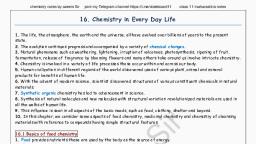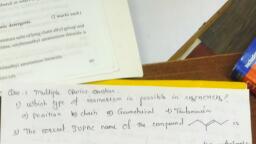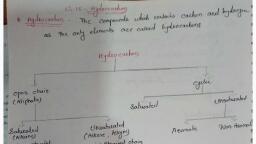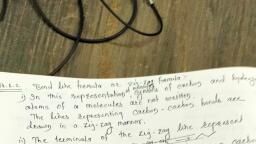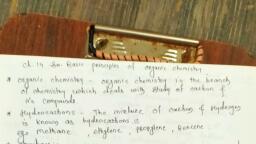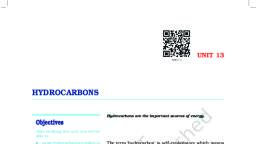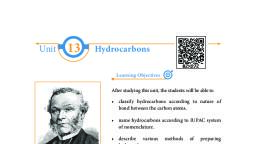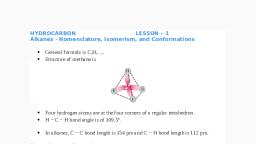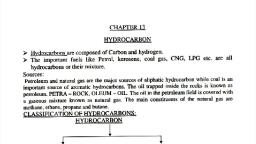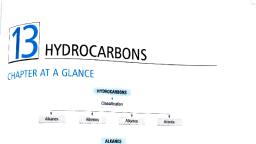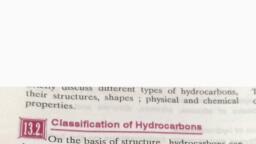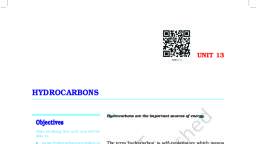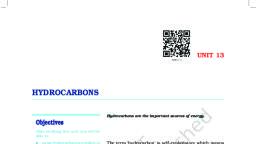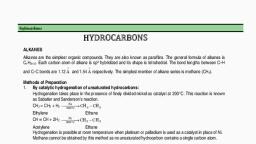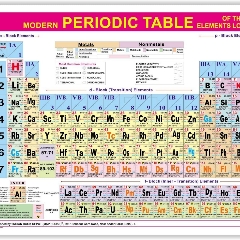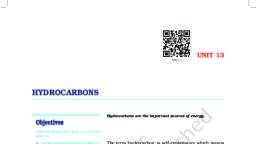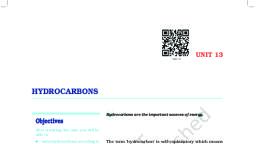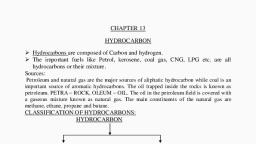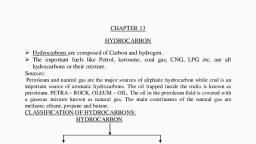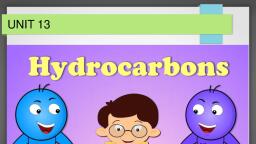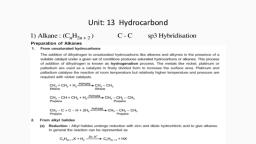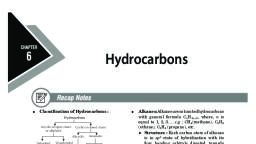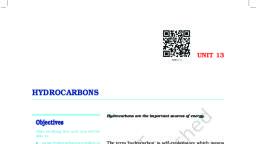Page 1 :
chemistry notes by azeem Sir, , joint my Telegram channel- https://t.me/stateboard11, , class 11 maharashtra notes, , 15. Hydrocarbon, , r, , 1. The compounds which contains carbon and hydrogen as the only elements are called hydrocarbons., 2. Hydrocarbons can be open chain or cyclic., 3. In accordance with presence or absence of carbon-carbon multiple bond (C = C and / or C \equivC) the, hydrocarbons are called unsaturated or saturated., 4. Cyclic unsaturated hydrocarbon can be either aromatic or nonaromatic (Fig. 15.1)., , ee, m, , Si, , 15.1 Alkanes, 1. Alkanes are aliphatic saturated hydrocarbons containing carbon-carbon and carbon-hydrogen single covalent, bonds., 2. You have learnt in Chapter 14 that alkanes have general formula 𝐂𝐧 𝐈𝟐𝐧+𝟐 where 'n' stands for the number of, carbon atoms in the alkane molecule., , Az, , 15.1.1 Isomerism in alkanes, 1. Alkanes with more than three carbon atoms generally exhibit, structural isomerism and in particular, the chain, isomerism (refer to section 14.5.1)., 2. Figure 𝟏𝟓. 𝟐 shows IUPAC and common names of stuctural isomers of C4 H10 and C5 H12 ., 3. The number of possible structural isomers increase rapidly with the number of carbon atoms. (See the Table, 15.1)., Table 15.1 : Alkanes and isomer number, , Number of Carbon, , Alkane, , Number of isomers, , 1, , Methane, , No structural isomer, , 2, , Ethane, , No structural isomer, , 3, , Propane, , No structural isomer, , 4, , Butane, , Two, , 5, , Pentane, , Three, , 6, , Hexane, , Five
Page 2 :
r, Si, ee, m, , Az, , 15.1.2 Conformation in alkanes :, 1. Alkanes have only single bonded atoms., 2. You have learnt that a single covalent bond is formed by coaxial overlap of orbital and is called sigma (𝝈) bond, (Refer to Chapter 5)., 3. As a direct consequence of coaxial overlap of orbitals, 𝑎 sigma bond is cylindrically symmetrical and the extent, of orbital overlap is unaffected by rotation about the single bond and therefore C-C bonds undergo rotation., 4. The atoms bonded to one carbon of a C-C single bond change, their relative position with reference to the atoms on the other, carbon of that bond on rotation of that C-C single bond., 5. The resulting arrangements of the atoms in space about the C, - C single bond are called conformations., 6. Innumerable conformations result on complete rotation of a C, - C single bond through 360∘ ., 7. In chapter 14 you have learnt about isomerism., 8. The phenomenon of existence of conformation is a type of, stereoisomerism., 9. In conformational isomerism the conformations (or, conformational isomers) interconvert by rotation about a C - C, single bond., 10. Out of infinite conformations of ethane molecule two are, extreme and called staggered and eclipsed conformation., 11. They are represented by Sawhorse formula and Newman, projection formula as shown in Fig. 15.3., 12. Conformational isomerism in other alkanes is more complex.
Page 3 :
15.1.3 Industrial preparation of alkanes, a. Industrial source :, 1. Crude petroleum and natural gas are the source of alkanes., 2. Dead plants buried under earth billions of year ago got converted into crude oil under the high temperature and, pressure conditions., 3. The crude oil collected in dome shaped cavities under the earth surface, which we call oil wells., 4. Alkanes are obtained by fractional distillation of crude oil in oil refineries., , ee, m, , Si, , r, , b. Methods of preparation of alkanes :, 1. From unsaturated hydrocarbons :, Catalytic hydrogenation of alkenes or alkynes with dihydrogen gas gives corresponding alkane., Finely divided powder of platinum (Pt) or palladium (Pd) catalyse the hydrogenation of alkenes and alkynes at room, temperature., Relatively high temperature and pressure are required with finely divided nickel as the catalyst., , Az, , 2. From alkyl halides, a. By reduction of alkyl halides :, Alkyl halides on reduction with zinc and dilute hydrochloric acid form alkanes., The reduction of alkyl halides is due to nascent hydrogen obtained from the reducing agent Zn and dilute HCl., , b. By using reactive metal :, In 19th century alkyl halide were transformed to alkane having double the number of carbons by Wurtz coupling, reaction using the reactive metal sodium.
Page 5 :
ee, m, , Si, , r, , 15.1.5 Chemical properties of alkanes :, Alkanes are relatively unreactive towards acids, bases, oxidizing and reducing agents., They undergo the following reactions under specified conditions., 1.Halogenation of alkanes :, i. The reactions in which an atom or group of atoms in a molecule is replaced by another atom or group of atoms are, known as substitution reactions., ii. Substitution of H atoms of alkanes by X (halogen, X = Cl, Br, I and F) atom is called halogenation of alkanes., iii. Alkanes react with halogens in presence of UV light or diffused sunlight or at higher temperature ( 573 To 773, K) to give mixture of alkyl halides., , Az, , iv. Tetrachloromethane is a major product when excess of chlorine is used., v. Chloromethane is obtained as major product when excess of methane is employed., vi. The reactivity of halogens toward alkanes follows the order, 𝐅𝟐 > 𝐂𝐥𝟐 > 𝐁𝐫𝟐 > 𝐈𝟐 ., vii. The ease of replacement of hydrogen atoms from the carbon is in the order of, , viii. Bromination gives corresponding bromides, but in different proportions. For example,
Page 7 :
4.Reforming :, Straight chain alkanes containing 6 to 10 carbon atoms are converted to benzene and its homologues on heating, under 10 to 20 atm pressure at about 773 K in the presence of V2 O5 , Cr2 O3 , Mo2 O3 etc. supported over alumina., The reaction involves simultaneous dehydrogenation and cyclization., This reaction is known as aromatization or reforming ., H3 C − CH2 − CH2 − CH2 − CH2 − CH3, n-Hexane, This process is used in refineries to produce high quality gasoline (the fuel used in automobiles)., 15.1.6 Uses of alkanes :, 1. First four alkanes are used as a fuel mainly for heating and cooking purpose. for example, LPG and CNG., 2. CNG, petrol, diesel are used as fuels for automobiles., 3. Lower liquid alkanes are used as solvent., 4. Alkanes with more than 35C atoms (tar) are used for road surfacing., 5. Waxes are high molecular weight alkanes. They are used as lubricants.They are also used for the preparation of, candles and carbon black that is used in manufacture of printing ink, shoe polish, etc., , Si, , r, , 15.2 Alkenes :, 1. Alkenes are unsaturated hydrocarbons containing a least one carboncarbon double bond., 2. Alkenes with one carboncarbon double bond, contain two hydrogen atoms less than corresponding alkanes., 3. They have general formula Cn H2n . where n = 2,3,4 … etc., 4. You have also learnt about the IUPAC names of alkenes in Chapter 14., , ee, m, , 15.2.1 Isomerism in alkenes:, Alkenes with more than three carbon atoms show both structural isomerism and geometrical isomerism., , Az, , i.Structural isomerism :, 1. Alkenes with molecular formula C4 H8 is butene. The structural formulae for C4 H8 can be drawn in three, diffferent ways :, , 2. Structure I and III along with II and III are the examples of chain isomerism., 3. They differ in carbon chain length., 4. Structure I and II are the examples of position isomerism because they differ in the position of double bond in, the same carbon chain., ii. Geometrical isomerism, 1. The isomerism which arises due to the difference in spatial arrangement of atoms or groups about doubly, bonded carbon (C = C) atoms is called geometrical isomerism., 2. If the two atoms or groups bonded to each end of the C = C double bond are different, then molecule can be, represented by two different special arrangements of the groups as follows :
Page 8 :
Si, , r, , 3. In structure (A), two identical atoms or groups lie on the same side of the double bond., 4. The geometrical isomer in which two identical or similar atoms or groups lie on the same side of the double bond, is called cis-isomer., 5. In structure (B), two identical atoms or groups lie on the opposite side of the double bond., 6. The geometrical isomer in which two identical or similar atoms or groups lie on the opposite side of the double, bond is called trans-isomer., 7. Due to different arrangement of atoms or groups in space, these isomers differ in their physical properties like, melting point, boiling point, solubility etc., 8. Geometrical or cis-trans isomers of but-2-ene are represented as :, , ee, m, , 15.3 Preparation of alkenes, a. Industrial sources :, 1.The most important alkenes for chemical industry are ethene, propene and buta-1,3-diene., 2. Alkenes containing upto four carbon atoms can be obtained in pure form from the petroleum products., 3. Ethene is produced from natural gas and crude oil by cracking., , Az, , b. Methods of preparation of alkenes, (I) Elimination reactions : (1,2 -elimination ), The reactions in which two atoms or groups are eliminated or removed from adjacent carbon atoms are called 𝟏, 𝟐 elimination reactions., , Some elimination reactions useful to prepare alkenes are described below., i. Dehydrohalogenation of alkyl halides, 1. Dehydrohalogenation means removal of hydrogen (𝐻) atom and halogen (𝑋) atom from adjacent carbon atoms., 2. The carbon carrying 𝑋 is called 𝜶-carbon atom., 3. The hydrogen atom from adjacent carbon called 𝜷-carbon atom, is removed and the reaction is known as 𝛽elimination., 4. Dehydrohalogenation suffers from the disadvantage that −H can be eliminated from the carbon on either side, of the 𝛼-carbon bearing the −𝑋., 5. When an alkyl halide is boiled with a hot concentrated alcoholic solution of a strong base like KOH or NaOH,, alkene is formed with removal of water molecule.
Page 12 :
(ii) Addition reaction of HBr to unsymmetrical alkenes :, Addition of HBr to unsymmetrical alkenes yield two isomeric products., , Experimentally it has been found that 2-Bromopropane is the major product. Russian chemist Markovnikov studied, hydrohalogenation of 𝑎 number of an unsymmetrical alkenes and formulated a geneneral rule (1869) as follows :, Markovnikov's rule:, When an unsymmetrical reagent is added to unsymmetrical alkene, the negative part (𝑋−) of the reagent gets, attached to the carbon atom which carries less number of hydrogen atoms., , Az, , ee, m, , Si, , r, , Anti- Markovnikov addition Or peroxide effect or Kharasch - Mayo effect :, In 1933, M. S. Kharasch and F. R. Mayo discovered that the addition of HBr to unsymmetrical alkene in the, presence of organic peroxide (R-O-O-R) takes place in the opposite orientation to that suggested, by Markovnikov 's rule., , 4. Addition of sulphuric acid, 1. Alkenes react with cold concentrated sulphuric acid to form alkyl hydrogen sulphate (ROSO3 H). The addition, takes place according to Markovnikov's rule.
Page 13 :
2. If alkyl hydrogen sulphate is diluted with water and heated, then an alcohol having the same alkyl group as the, original alkyl hydrogen sulphate is obtained., 3. This is an excellent method for the large scale manufacture of alcohols., , ee, m, , Si, , r, , 4. Reactive alkenes on adding water molecules in the presence of concentrated sulphuric acid, form alcohol., 5. The addition of water takes place according to Markovnikov's rule., 6. This reaction is known as hydration of alkenes., , Az, , 5. Ozonolysis of alkenes :, 1. The C = C double bond gets cleaved on reaction with ozone followed by reduction., 2. This overall process of formation of ozonide by reaction of ozone with alkene in the first step and then, decomposing it to the carbonyl compounds by reduction in the second step is called ozonolysis., , 3. Ozone gas is passed into solution of the alkene in an inert solvent, like carbon tetrachloride, unstable alkene ozonide is obtained., 4. This is subsequently treated with water in the presence of a, reducing agent zinc dust to form carbonyl compounds, namely,, aldehydes and/or ketones .
Page 14 :
ee, m, , Si, , r, , 6.Hydroboration- oxidation of alkene, Alkenes with diborane in tetrahydrofuran (THF) solvent undergo hydroboration to form trialkylborane, which on, oxidation with alkaline peroxide forms primary alcohol. The overall reaction gives Anti-Markovnikov's product from, unsymmetrical alkenes, , Az, , 7. Polymerization :, 1. The process in which large number of small molecules join together, and form very large molecules with repeating units is called, polymerization., 2. The compound having very large molecules made of large number, repeating small units is called polymer and the simple compound, forming the repeating units in the polymer is called monomer., 3. For example, ethene at high temperature and under high pressure, interacts with oxygen, and undergoes polymerization giving high, molecular weight polymer called polyethene., 4. Here n represents the number of repeating units and is a large, number., 8. Hydroxylation :, 1. Alkenes react with cold and dilute alkaline potassium permanganate to, form glycols., 2. Hydroxylation of alkenes is the most important method for the, synthesis of 1,2 -diols (Glycols)., 3. During this reaction the purple colour of KMnO4 disappears., 4. Hence such reaction serves as qualitative test for detecting the, presence of double bond in the compound under test., 5. This is known as Baeyer's test.
Page 17 :
15.3.3 Physical properties of alkynes:, 1. The physical properties of alkynes are similar to those of alkanes and alkenes., 2. They are less dense than water., 3. They are insoluble in water and quite soluble in less polar organic solvents like ether, benzene, carbon, tetrachloride., 4. The melting points and boiling points of alkynes increase with an increase in molecular mass (Table 15.5)., Table 15.5 : Melting point and Boiling point of alkynes, Name, , Molecular mass/u, , Physical State, , b.p.(K), , m.p.(K), , 𝐂𝐇 = 𝐂𝐇, , Ethyne, , 26, , Gas, , 198, , 191, , 𝐂𝐇 = 𝐂𝐂𝐇𝟑, , Propyne, , 40, , Gas, , 250, , 𝟏𝟕𝟏. 𝟓, , 𝐂𝐇 = 𝐂𝐂𝐇𝟐 𝐂𝐇𝟑, , But-1-yne, , 54, , Gas, , 282, , 151, , 𝐂𝐇 = 𝐂(𝐂𝐇𝟐 )𝟐 𝐂𝐇𝟑, , Pent-1-yne, , 68, , Liquid, , 313, , 175, , 𝐂𝐇 = 𝐂(𝐂𝐇𝟐 )𝟑 𝐂𝐇𝟑, , Hex-1-yne, , 82, , Liquid, , 345, , 149, , r, , Formula, , Az, , ee, m, , Si, , 15.3.4 Chemical properties of alkynes :, I Acidity of alkynes :, 1. The hydrogen bonded to C ≡ C triple bond has acidic character., 2. Lithium amide ( LiNH2 ) is very strong base and it reacts with terminal alkynes to form lithium acetylides with, the liberation of hydrogen indicating acidic nature of terminal alkynes., 3. Why is it so ? In terminal alkynes, hydrogen atom is directly attached to 𝑠𝑝 hybridized carbon atom., 4. In 𝑠𝑝 hybrid orbital, the percentage of s- character is 50%., 5. An electron in s-orbital is very close to the nucleus and is held tightly., 6. The sp hybrid carbon atom in terminal alkynes is more electronegative than the sp2 carbon in ethene or the sp3, carbon in ethane., 7. Due to high electronegative character of carbon in terminal alkynes, hydrogen atom can be given away as proton, (H + )to very strong base., Examples, , II Addition of dihydrogen (See method of preparation of alkenes from unsaturated hydrocarbons)
Page 18 :
III Addition of halogens, , Az, , ee, m, , Si, , IV Addition of hydrogen halides, 1. Hydrogen halides (HCl, HBr and HI) add to alkynes across, carbon-carbon triple bond in two steps to form geminal dihalides, (in which two halogen atoms are attached to the same carbon, atom)., 2. The addition of HX in both the steps takes place according, to Markovnikov's rule., , r, , Red-brown colour of solution of bromine in carbon tetrachloride disappears. This test can be used to detect the, presence of unsaturation in given compound.
Page 19 :
V Addition of water, , ee, m, , Si, , r, , Alkynes react with water in presence of 40% sulphuric acid and 1% mercuric sulphate to form aldehydes or, ketones i.e. carbonyl compounds., , Az, , 15.3.5 Uses of acetylene :, 1. Ethyne (acetylene) is used in preparation of Ethanal (acetaldehyde), Propanone (acetone),, ethanoic acid (acetic acid)., 2 .It is used in the manufacture of polymers, synthetic rubber, synthetic fibre, plastic etc., 3 .For artificial ripening of fruits., 4. In oxy-acetylene ( mixture of oxygen and acetylene) flame for welding and cutting of, metals., 15.4 Aromatic Hydrocarbons:, 1. Many organic compounds obtained from natural sources like resins, balsams, oil of wintergreen, etc. possessing, pleasant fragrance (aroma = smell) are named as aromatic compounds., 2. Aromatic hydrocarbons (also called arenes) contain only carbon and hydrogen. Benzene is the simplest aromatic, compound., 3. Benzene and all compounds that have structures and chemical properties, resembling benzene are classified as aromatic compounds. Examples are:
Page 20 :
15.4.1 Benzene :, 1. The molecular formula of benzene is C6 H6 ., 2. Benzene is parent compound of most of the aromatic compounds., 3. Coal-tar and petroleum are the two large-scale sources of benzene (and aromatic compounds like toulene, phenol,, naphthalene.)., 4. It is a colourless liquid having characteristic odour., 5. Its boiling point is 353 K., 6. It was synthesized by Berthelot (1870) from acetylene. Benzene was originally called phene and hence C6 H5 is, called phenyl group., , ee, m, , Si, , r, , Table 15.6 : Difference between aromatic and aliphatic compounds, Aromatic compounds, Aliphatic compounds, 1. Aromatic compounds contain higher percentage of, 1. Aliphatic compounds contain lower percentage of, carbon., carbon., 2. They burn with sooty flame., 2. They burn with non-sooty flame., 3. They are cyclic compounds with alternate single, 3. They are open chain compounds., and double bonds., 4. They are not attacked by normal oxidizing and, 4. They are easily attacked by oxidizing and reducing, reducing agents., agents., 5. They do not undergo addition reactions easily., 5. Unsaturated aliphatic compounds undergo addition, They do not decolourise dilute alkaline aqueous, reactions easily.They decolourise dilute aqueous, 𝐊𝐌𝐧𝐎𝟒 and 𝐁𝐫𝟐 in 𝐂𝐂𝐥𝟒 , though double bonds appear, alkaline 𝐊𝐌𝐧𝐎𝟒 and 𝐁𝐫𝟐 in 𝐂𝐂𝐥𝟒 ., in their structure., 6. The saturated aliphatic compounds give, 6. They prefer substitution reactions., substitution reactions., , Az, , 15.4.2 Structure of benzene :, 1. Molcular formula of benzene, C6 H6 , indicates the high degree of unsaturation., 2. Open chain structure NOT possible : Open chain or cyclic structure having double and triple bonds can be, written for C6 H6 . But benzene does not behave like alkenes or alkynes (see Table 15.7). This indicates that, benzene can not have the open chain structure., Table 15.7: Comparative reactivity of alkenes and benzene, , Reaction, , Alkene, , Benzene, , With dil. alka. 𝐊𝐌𝐧𝐎𝟒, , Decolourisation of 𝐊𝐌𝐧𝐎𝟒, , No decolourisation, , With 𝐁𝐫𝟐 in 𝐂𝐂𝐥𝟒, , Decolourisation of red brown colour of bromine, , No decolourisation, , With 𝐇𝟐 𝐎 in acidic medium, , Addition of 𝐇𝟐 𝐎 molecule, , No reaction, , 3. Evidence of cyclic structure:, i. Benzene yields only one and no isomeric monosubstituted bromobenzene (C6 H5 Br) when treated with equimolar, bromine in FeBr3 ., ii. This indicates that all the six hydrogen atoms in benzene are identical., 𝐅𝐞𝐁𝐫𝟑, , 𝐂𝟔 𝐇𝟔 + 𝐁𝐫𝟐 ⟶ 𝐂𝟔 𝐇𝟓 𝐁𝐫 + 𝐇𝐁𝐫
Page 21 :
iii. This is possible only if benzene has cyclic structure of six carbons bound to one hydrogen atom each., Benzene on catalytic hydrogenation gives cyclohexane., Ni, , C6 H6 + 3H2 ⟶ C6 H12, Benzene, , Cyclohexane, , This confirms the cyclic structure of benzene and three C = C in it., 4. Kekulé structure of benzene :, i. August Kekulé in 1865 suggested the structure for benzene having a cyclic planar ring of six carbon atoms with, alternate single and double bonds and hydrogen atom attached to each carbon atom., , Si, , r, , ii. The Kekulé structure indicates the possibility of two isomeric 1,2 -dibromobenzenes., iii. In one of the isomers, the bromine atoms would be attached to the doubly bonded carbon atoms whereas in the, other, they would be attached to single bonded carbons., , ee, m, , iv. However, benzene was found to form only one ortho-disubstituted benzene., v. This problem was overcome by Kekule' by suggesting the concept of oscillating nature of double bonds in, benzene as given below., , vi. Even with this modification, Kekule' structure of benzene failed to explain unusual stability and preference to, substitution reactions rather than addition reactions, which was later explained by resonance., , Az, , 5. Stability of benzene:, i. Benzene is a hybrid of various resonance structures., ii. The two structures, A and B given by Kekulé are the main contributing structures., iii. The resonance hybrid is represented by inserting a circle or a dotted circle inscribed in the hexagon as shown, in (C)., iv. The circle represents six electrons delocalized over the six carbon atoms of benzene ring., , v. A double headed arrow between the resonance structures is used to represent the resonance phenomenon., vi. Stability of benzene :, The actual molecule is more stable than any of its resonance structures. For benzene, the stability due to, resonance is so high that 𝜋-bonds of the molecule resist breaking. This explains lack of reactivity of benzene, towards addition., vii. The orbital overlap gives us better picture of structure of benzene., viii. All six carbon atoms in benzene are 𝑠𝑝2 hybridised. Two 𝑠𝑝2 hybrid, orbitals of carbons overlap and form carboncarbon sigma (𝜎) bond and the, remaining third 𝑠𝑝2 hybrid orbital of each carbon overlaps with s orbital of a, hydrogen atom to form six C − H sigma bonds.
Page 22 :
ix. The unhybrid p orbitals of carbon atoms overlap laterally forming 𝜋 bonds., x. There are two possibilities of forming three 𝜋 bonds by overlap of p orbitals of C1 −, C2 , C3 − C4 , C5 − C6 or C2 − C3 , C4 − C5 , C6 − C1 , respectively, as shown in Fig. 𝟏𝟓. 𝟓; both, are equally probable., xi. According to resonance theory (Chapter 5 ) these are two resonance structures of, benzene., xii. According to molecular orbital (MO) theory (Chapter 5) the six p orbitals of six, carbons give rise to six molecular orbitals of benzene., xiii. Shape of the most stable MO is as shown in Fig. 15.6., Three of these 𝜋 molecular orbitals lie above and the other below those of free, carbon, xiv. The six electrons of the p orbitals cover all the six carbon atoms and are said to, be delocalized. Delocalization of 𝜋 electrons results in stablity of benzene molecule., , ee, m, , Si, , r, , 6. Bond parameters of benzene :, i. X-ray diffraction data indicate that all C-C bond lengths in benzene are equal ( 139pm ) which is an intermediate, between C-C (154pm) and 𝐶 = 𝐶 bond (133pm)., ii. Thus absence of pure double bond in benzene accounts for its reluctance to addition reactions under normal, conditions, which explains unusual behavior of benzene., , Az, , 15.4.3 Aromatic character (Huckel Rule):, 1. Benzene undergoes substitution reaction rather than addition reactions., 2. This property is common to all aromatic compounds and is referred to as aromaticity or aromatic character., 3. The aromatic character of benzene is correlated to its structure., 4. Aromaticity is due to extensive cyclic delocalization of p electrons in planar ring structures., The following three rules of aromaticity are useful in predicting whether a particular compound is, aromatic or non-aromatic., 1. Aromatic compounds are cyclic and planar (all atoms in ring are sp 2 hybridized)., 2. Each atom in aromatic ring has a p-orbital. The p-orbitals must be parallel so that continuous overlap is possible, around the ring., 3. Huckel Rule :, The cyclic 𝜋 molecular orbital formed by overlap of p-orbitals must contain ( 4n + 2 ) p electrons, where n = integer, 0,1,2,3 ...etc., Let us apply these rules to the following compounds
Page 23 :
1.Benzene :, It is cyclic and planar. It has three double bonds and six 𝜋 electrons., It has a 𝑝 orbital on each carbon of the hexagonal ring., Hence a continuous overlap above and below the ring is posssible., This compound is aromatic, 4n + 2 = Number of 𝜋 electrons., 4𝑛 + 2 = 6, ∴ 4𝑛 = 6 − 2 = 4, n = 4/4 = 1,, Here ' n ' comes out to be an integer., Hence benzene is aromatic., , Si, , r, , 2. Naphthalene :, It is cyclic and planar. It has 5 double bonds and 10𝜋 electrons., It has p orbital on each carbon atom of the ring. Hence a continuous overlap around the ring is posssible., This is in accordance with Huckel rule., 4n + 2 = Number of 𝜋 electrons, 4n + 2 = 10, ∴ 4n = 10 − 2 = 8, n = 8/4 = 2, Here ' n ' comes out to be an integer., Hence napthalene is aromatic., , ee, m, , 3. Pyridine :, Pyridine has three double bonds and 6𝜋 electrons., The six p orbital containing six electrons form delocalized p molecular orbital., The unused sp2 hybrid orbital of nitrogen containing two non-bonding electrons is, as it is., 4𝑛 + 2 = Number of 𝑝 electrons, n = 4/4 = 1, Here ' 𝑛 ' comes out to be an integer., Hence pyridine is aromatic., , Az, , 4. Cycloheptatriene:, It is cyclic and planar., It has three double bonds and 6𝜋 electrons., But one of the carbons is saturated (sp3 hybridized) and does not possess a p, orbital., Hence a continuous overlap around the ring is not possible., Therefore, it is non- aromatic., 15.4.4 Preparation of aromatic compounds, a. Industrial source of aromatic compounds, Coal tar and petroleum are major sources of aromatic compounds., b. Methods of preparation of benzene, 1.From ethyne (By trimerization) :, Alkynes when passed through a red hot iron tube at 873K, polymerize to form aromatic hydrocarbons., Ethyne when passed through a red hot iron tube at 873 K, undergoes trimerization to form benzene., , 2. From sodium benzoate :
Page 24 :
(By decarboxylation), When anhydrous sodium benzoate is heated with soda-lime it gives benzene., 3. From phenol ( By reduction) :, When vapours of phenol are passed over heated zinc dust, it gives benzene., , 15.4.4 Physical properties of benzene, 1. Benzene is colourless liquid., 2. Its boiling point is 353 K and melting point is 278.5 K., 3. It is isoluble in water. It forms upper layer when mixed with water., 4. It is soluble in alcohol, ether, and chloroform., 5. Benzene vapours are highly toxic which on inhalation lead to unconsciousness., 15.4.6 Chemical properties of benzene, Aromatic compounds are characterised by electrophilic substitution reactions. However, they undergo addition and, oxidation reactions under special conditions. Some reactions of benzene are discussed below., , ee, m, , Si, , r, , I. Addition reactions, i. Addition of chlorine :, Benzene when treated with chlorine in presence of bright sunlight or UV light, adds up three molecules of chlorine, to give benzene hexachloride., , 𝛾 - isomer of benzene hexachloride is called gammexane or lindane which is used as insecticide., , Az, , ii. Addition of hydrogen :, When a mixture of benzene and hydrogen gas is passed over heated catalyst nickel at 453 K to 473 K,cylohexane is, formed., , iii. Addition of ozone:, When benzene is treated with ozone in presence of an inert solvent, carbon tetrachloride, benzene triozonide is formed which is then, decomposed by zinc dust and water to give glyoxal., , II. Substitution reactions :
Page 25 :
Benzene shows electrophilic substitution reactions, in which one or more hydrogen atoms of benzene ring are, replaced by electrophilic groups like -Cl, −Br, −NO2 , −SO3 H, −R (alkyl group), -COR (Acyl group) etc. (see Chapter, 14)., i. Halogenation :, In this reaction, hydrogen atom of benzene ring is replaced by halogen atom., , Chlorine reacts with benzene in dark in the presence of iron or ferric chloride or anhydous aluminium chloride or, red phosphorous as catalyst to give chlorobenze., Electrophile : Cl⊕ , Chloronium ion, Formation of the electrophile:, Cl − Cl + FeCl3 ⟶ Cl⊕ + [FeCl4 ]⊖, , Electrophile: Br ⊕ ,, Formation of electrophile :, Br − Br + FeBr3 ⟶ Br ⊕ + [FeBr4 ]⊖, , ee, m, , Si, , r, , Bromination of benzene is similar chlorination :, , Az, , Iodination of benzene is not possible as it is reversible process., With excess of chlorine, benzene gives hexachlorobenzene., , When benzene is heated with a mixture of concentrated nitric acid and concentrated sulfuric acid (nitrating, mixture) at about 313 K to 333 K, it gives nitrobenzene.
Page 27 :
Formation of the electrophile: R − COCl + AlCl3 ⟶ R − C ⊕ = O + AlCl⊖, 4, 6. Combustion :, When benzene is heated in air, it burns with sooty flame forming carbon dioxide and water., 𝐂𝟔 𝐇𝟔 + 𝟏𝟓/𝟐𝐎𝟐 ⟶ 𝟔𝐂𝐎𝟐 + 𝟑𝐇𝟐 𝐎, General combustion reaction for any hydrocarbon (Cx Hy ) can be represented as follows:, 𝐂𝐱 𝐇𝐲 + (𝐱 + 𝐲/𝟒)𝐎𝟐 → 𝐱𝐂𝐎𝟐 + 𝐲/𝟐𝐇𝟐 𝐎, 15.4.7 Directive influence of a functional group in monosubstituted benzene, Structure of benzene :, , In benzene, all hydrogen atoms are equivalent., Therefore, only one product is possible when it undergoes electrophilic substitution reactions., , ee, m, , Si, , r, , Monosubstituted benzene :, , Az, , Positions of carbon atoms in mono substituted benzene :, 1.The positions 2 and 6 are equivalent and give ortho (o-) products., 2. The position 3 and 5 are equivalent and give meta (m-) products., 3. The position 4 is unique and and gives para (p-) product., 4. Now in benzene, five positions are available for electrophilic substitution., 5. When monosubstituted benzene is subjected to further electrophilic substitution, the second substituent i.e., electrophile (see Chapter 14) or incoming group (E) can occupy any of these positions and give three disubstituted, products., 6. But these products are not formed in equal amounts., , Two types of behaviour are observed., a. ortho- and para - products or b. metaproducts are found as major products :
Page 28 :
This behaviour mainly depends on the nature of the substituent (S) already present in the benzene ring and not on, the nature of second substituent (E) i.e. incoming group., Ortho and para directing groups:, ¨ : , −𝐁𝐫, ¨ : , −𝐎¨ − 𝐇, −𝐎¨ − 𝐂𝐇𝟑 ,, −𝐂𝐥, ¨ 𝟐 , −𝐍𝐇𝐑, ¨, −𝐍𝐇, , −𝐂𝐇𝟑 , −𝐂𝟐 𝐇𝟓 , −𝐑 etc., The groups which direct the incoming group to ortho and para positions are called ortho and para directing groups., , Si, , r, , Ortho und para directive influence of -OH group :, 1. The resonance theory clearly explains why certain substituents are ortho/para or meta directing., 2. Let us study the various resonance structures of phenol (see Chapter 14)., , Az, , ee, m, , 3. It is clear from the above resonance structures that the ortho and para positions have a greater electron, density than the meta positions., 4. Therefore, -OH group activates the benzene ring for the attack of second substituent 𝐸 at these electron -rich, centres., 5. All ortho and para directing groups possess nonbonding electron pair on the atom which is directly attached to, aromatic ring., 6. Methyl group is an exception :, The only exception to above rule is methyl or alkyl groups. It is ortho and pora directing, although it has no, nonbonding electron pair on the key atom. This is explained on the basis of special type of resonance called, hyperconjugation or no bond resonance (see Chapter 14)., 7. In case of aryl halides, halogens are moderately deactivating., 8. Because of their strong -I effect, overall electron density on the benzene ring decreases., 9. It makes the electrophilic substitution difficult., 10. However, due to resonance the electron density on ortho and para positions is greater than meta positions., 11. Halogens are ortho and para directing., 12. Let us study the various resonating structures of chlorobenzene.
Page 29 :
13. All meta directing groups have positive (or partial positive) charge on, the atom which is directly attached to an aromatic ring., 14. The groups which direct the incoming group to meta positions are, called meta directing groups., , ee, m, , Si, , r, , Metadirective influence of −𝐍𝐎𝟐 group can be explained by resonance, theory :, 1. Meta directing group withdraws electrons from the aromatic ring by, resonance, making the ring electron-deficient., 2. Therefore, meta groups are ring deactivating groups., 3. Due to -I effect, −NO2 group reduces electron density in benzne ring, on ortho and para positions., 4. So the attack of incoming group becomes difficult at ortho and para, positions., 5. Incoming group can attack on meta positions more easily. Let us study, the various resonance structures of nitrobenzene., 6. It is clear from the above resonance structures that the ortho and, para positions have comparatively less electron density than at meta positions., 7. Hence, the incoming group/ electrophile attacks on meta positions., , Az, , 15.4.6 Carcinogenicity and Toxicity :, 1. Benzene is both toxic and carcinogenic (cancer causing)., 2. In fact, it might be considered "the mother of all carcinogens" as a large number of carcinogens have, structures those include benzene rings., 3. Several polycyclic aromatic compounds (containing more than two fused benzene rings) are produced by, incomplete combustion of tobacco, coal and petroleum., 4. In liver, benzene is oxidized to an epoxide., 5. Benzopyrene is converted into an epoxy diol., 6. These substances are carcinogenic and can react with DNA which can induce mutation leading to uncontrolled, growth of cancer cells.
Page 30 :
Exercises, 1 Choose correct options, A. Which of the following compound has highest boiling point ?, a. n-pentane, b. iso-butane, c. butane, d. neopentane, B. Acidic hydrogen is present in :, a. acetylene, b. ethane, c. ethylene, d. dimethyl acetylene, , a. KMnO4 /H +, b. alkaline KMnO4, c. dil. H2 SO4 /1%HgSO4, d. NaOH/H2 O2, , ee, m, , Si, , r, , C. Identify 'A' in the following reaction:, , Az, , D. Major product of chlorination of ethyl benzene is :, a. m-chlorethyl benzene, b. p - chloroethyl benzene, c. chlorobenzene, d. o – chloroethylbenzene, E. 1 - chloropropane on treatment with alc. KOH produces :, a. propane, b. propene, c. propyne, d. propyl alcohol, 2. Name the following :, A. The type of hydrocarbon that is used as lubricant., B. Alkene used in the manufacture of polythene bags., C. The hydrocarbon said to possess carcinogenic property., D. What are the main natural sources of alkane?, , E. Arrange the three isomers of alkane with malecular formula C5 H12 in increasing order of boiling points and write, their IUP\LambdaC names.
Page 31 :
F. Write IUPAC names of the products obtained by the reaction of cold concentrated sulphuric acid followed by, water with the following compounds., a. propene, b. but-l-ene, G. Write the balanced chemical reaction for preparation of ethane from, a. Ethyl bromide, b. Ethyl magnesium iodide, H. How many monochlorination products are possible for, a. 2-methylpropane ?, b. 2-methylbutane ?, Draw their structures and write their IUPAC names., I. Write all the possible products for pyrolysis of butane., , ee, m, , Si, , r, , J. Which of the following will exhibit geometical isomerism ?, , 𝐾. What is the action of following on ethyl iodide ?, a. alc, KOH, b. Zn, HCl, , Az, , L. An alkene 'A' an ozonolysis gives 2 moles of ethanal. Write the structure and IUPAC name of 'A'., M. Acetone and acetaldehyde are the ozonolysis products of an alkene. Write the structural formula of an alkene, and give IUPAC name of it., N. Write the reaction to convert, a. propene to nypropylalcohol., b. propene to isoproyl alcohol., , O. What is the action of following on but-2-ene ?, a. dil alkaline KMnO4, b. acidic KMnO4, P. Complete the following reaction sequence :, LiNH3, , CH3 CH2 Cl, , HBr, , HC ≡ CH ⟶ A ⟶ B ⟶ C, Comment on the acidic nature of B., Q. Write the balanced chemical reactions to get benzene from, a. Sodium benzoate., b. Phenol.
Page 32 :
R. Predict the possible products of the following reaction., a. chlorination of nitrobenzene,, b. sulfonation of chlorobenzene,, c. bromination of phenol,, d. nitration of toluene., 3. Identify the main product of the reaction, , Read the following reaction and answer the questions given below., , a., , Write IUPAC name of the product., b. State the rule that governs formation of this product., , 5, , Identify 𝐀, 𝐁, 𝐂 in the following reaction sequence :, , 6, , Identify giving reason whether the following compounds are aromatic or not., , 7, , Name two reagents used for acylation of benzene., , Az, , ee, m, , Si, , r, , 4
Page 33 :
8, , Read the following reaction and answer the questions given below., , A. Write the name of the reaction., B. Identify the electrophile in it., , Az, , ee, m, , Si, , r, , C. How is this electrophile generated?
